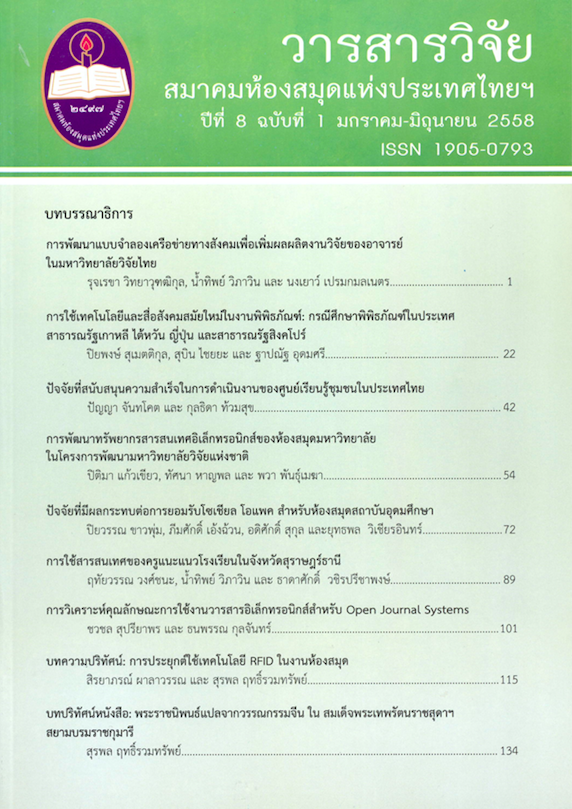การใช้เทคโนโลยีและสื่อสังคมสมัยใหม่ในงานพิพิธภัณฑ์: กรณีศึกษาพิพิธภัณฑ์ในประเทศสาธารณรัฐเกาหลี ไต้หวัน ญี่ปุ่น และสาธารณรัฐสิงคโปร์
Main Article Content
Abstract
การวิจัยครั้งนี้มีวัตถุประสงค์เพื่อศึกษา 1) การใช้เทคโนโลยีและสื่อสังคมสมัยใหม่ในพิพิธภัณฑ์ชั้นนำของเอเชีย 2) สภาพปัจจุบันและสภาพที่พึงประสงค์ของการใช้เทคโนโลยีและสื่อสังคมสมัยใหม่ในพิพิธภัณฑ์ชั้นนำของเอเชีย 3) เพื่อจัดลําดับความต้องการจำเป็นในการใช้เทคโนโลยีและสื่อสังคมสมัยใหม่ในพิพิธภัณฑ์ชั้นนำของเอเชีย กลุ่มตัวอย่างที่ใช้ในการวิจัย คือ ผู้บริหารของพิพิธภัณฑ์ชั้นนำของเอเชียทั้ง 8 แห่ง ๆ ละ 2 คน รวมทั้งสิ้น 16 คน เครื่องมือที่ใช้ในการเก็บรวบรวมข้อมูล ได้แก่ แบบสัมภาษณ์ และแบบสอบถาม ซึ่งแบบสอบถามเป็นแบบมาตราส่วนประมาณค่า 5 ระดับ (Rating scale) มีการวิเคราะห์ข้อมูลโดยการแจกแจงความถี่ ร้อยละ ค่าเฉลี่ย และจัดลําดับความต้องการจําเป็นโดยใช้สูตร PNI modified
ผลการวิจัย พบว่า ในภาพรวม มีชนิดสื่อที่ใช้ในงานพิพิธภัณฑ์ทั้งหมด จำนวน 560 รายการ โดยเป็นสื่อสังคม จำนวน 192 รายการ (ร้อยละ 34.29) สื่อภาพ จำนวน 168 รายการ (ร้อยละ 30.00) สื่อเสียง จำนวน 80 รายการ (ร้อยละ 14.29) สื่อประสม จำนวน 72 รายการ (ร้อยละ 12.86) และสื่อเสมือนจริง จำนวน 48 รายการ (ร้อยละ 8.57) อย่างไรก็ตาม ในการปฏิบัติจริง มีการใช้สื่อภาพเพียง 126 รายการ (ร้อยละ 37.95) สื่อสังคม จำนวน 96 รายการ (ร้อยละ 28.92) สื่อเสียง จำนวน 55 รายการ (ร้อยละ 16.57) สื่อประสม จำนวน 45 รายการ (ร้อยละ 13.55) และสื่อเสมือนจริง จำนวน 10 รายการ (ร้อยละ 3.01)
เมื่อศึกษาสภาพการปฏิบัติในปัจจุบันและสภาพการปฏิบัติที่พึงประสงค์ พบว่า มีสภาพการปฏิบัติในปัจจุบันและมีสภาพการปฏิบัติที่พึงประสงค์อยู่ในระดับปานกลาง (1.64 และ 2.47 จาก 4.00 ตามลำดับ) เมื่อจัดลําดับความต้องการจําเป็นของการใช้เทคโนโลยีและสื่อสังคมสมัยใหม่ในงานพิพิธภัณฑ์ โดยเรียงลําดับจากค่ามากที่สุดไปหาค่าที่น้อยที่สุด คือ 1) งานบริการเชิงธุรกิจการค้า (1.19) งานบริการอื่นๆ (0.67) และงานบริการข้อมูลข่าวสารเพื่อการประชาสัมพันธ์ (0.40) และงานบริการข้อมูลองค์ความรู้และการนำเสนอความรู้ (0.40) เท่ากัน ตามลําดับ
The use of technology and social media in museum work: A case study of museums in the Republic of Korea, the Republic of China, Japan, and the Republic of Singapore
Piyapong Sumettikoon1, Subin Chaiya2, Thapanut Udomsree2
1 Ed.D. (Educational Administration), Lecturer, Department of Educational Policy, Management, and Leadership, Faculty of Education, Chulalongkorn University E-mail: dregchula@gmail.com
2 Ph.D. Candidate (Educational Administration), Department of Educational Policy, Management, and Leadership, Faculty of Education, Chulalongkorn University
The purposes of the study were to 1) study the use of technology and social media in leading museums in Asia 2) study the current practice and future expectations on the use of technology and social media in leading museums in Asia, and 3) to rank technology and social media by needs in leading museums in Asia. The samples of the study were 16 museum administrators from 8 leading museums in Asia. Questionnaires and interview questions were used as tools to collect quantitative and qualitative data respectively. Frequency, mean/average, and PNI modified were used to analyze the collected data.
The study identified a total of 560 technology and social media items in museum work in which 192 items were of online technology (34.29 percent), 168 items were of images (30 percent), 80 items were of sound technology (14.29 percent), 72 items were of mixed media technology (12.86 percent), and 48 items were virtual reality technology (8.57 percent). However, in reality, only 126 items of image technology (37.95 percent), 96 items of online technology (28.92 percent), 55 items of sound technology (16.57 percent), 45 items of mixed media technology (13.55 percent), and 10 items of virtual reality technology (3.01 percent) were used in all museums included in the study.
The study of current practice and future expectation found both to be at a moderate level (1.64 and 2.47 out of 4.00 respectively). When ranked by priority of needs for technology and social media, the study found the needs from highest to lowest to be business service work (1.19), other work (0.67), information and public relations work (0.40), and presentation of knowledge and information work (0.40) respectively.
Article Details
บทความทุกเรื่องที่ลงตีพิมพ์จะได้รับการตรวจอ่านโดยผู้ทรงคุณวุฒิ ความคิดเห็นและบทความที่ปรากฏในวารสารนี้ เป็นของผู้เขียนซึ่งมิใช่เป็นความคิดเห็นของคณะผู้จัดทำ และมิใช่ความรับผิดชอบของสมาคมห้องสมุดแห่งประเทศไทยฯ การนำบทความในวารสารนี้ไปตีพิมพ์ซ้ำต้องได้รับอนุญาตจากคณะผู้จัดทำ
All articles submitted for publication will be reviewed by the academic reviewers. The editorial board and TLA claim no responsibility for the content or opinions expressed by the authors of individual articles or columns in this journal. Reprinting of any articles in this journal must be permitted by the editorial board.


